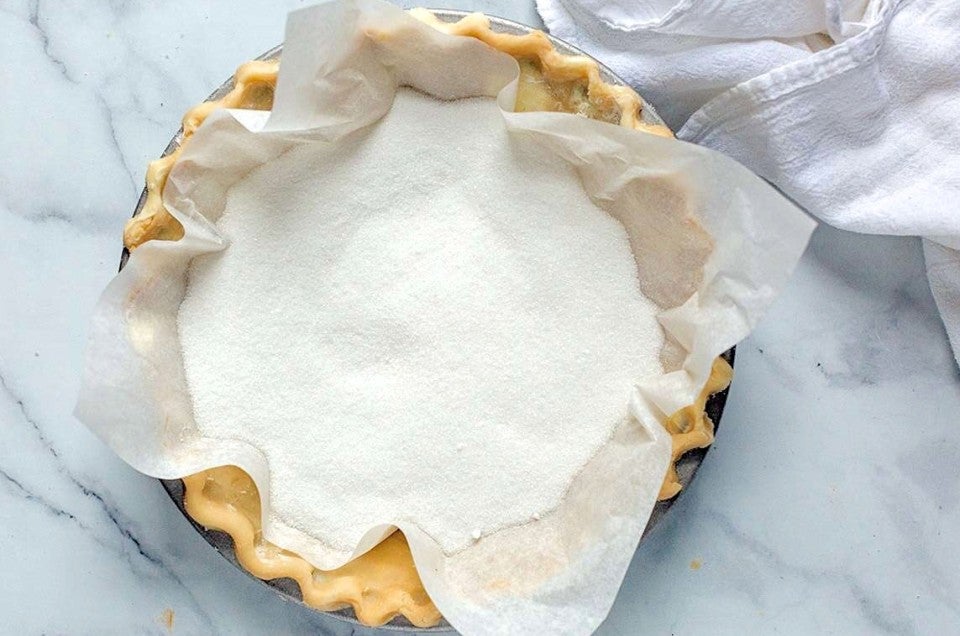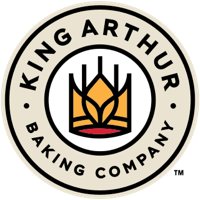How to prebake pie crust — and why you should
The key to flaky — not flabby — pie crust.


A soggy bottom. Not something you want for your baby. Or your pie crust. And while we can’t help you with your baby, there’s a simple solution to pies with soggy bottoms: prebake the crust.
There are a number of reasons your pie can end up with a soft, pale, underbaked crust — and steps you can take to help prevent that unfortunate result.
But the one surefire way to make certain your pie’s crust will be golden brown, crisp, and delicious — just as appealing as its filling — is to prebake it. That’s right: bake the bottom crust first, before adding the filling.
Most commonly, it's smart to prebake pie crust when:
A typical pastry pie crust (as opposed to a graham cracker or cookie crust) requires quite a long time in the oven to become golden brown and crispy. This isn’t a problem when the filling is fruit: apples, peaches, blueberries, and their ilk soften and then settle down to a gentle simmer as the crust gradually bakes to perfection for a long while in the oven.

But some fillings might instead cook fully on the stovetop, like the rich, thick filling for chocolate cream pie. When it’s done, you simply pour it into its crust — and said crust had better be prebaked to perfection, since the pie’s not going anywhere near an oven.
Other pies, typically those with a more delicate, egg- and cream-based filling (think custard pie or quiche) require at least some baking — but don’t spend long enough in the oven (at a high enough temperature) to guarantee a fully baked, brown and crispy crust.
In these cases, you need to prebake your crust.
The recipe you're following may explain explicitly how to prebake your crust. But if it doesn't, follow this process:
First, roll your bottom crust and place it in the pan. Crimp or flatten the edge. Chill it for 30 minutes, to relax the gluten and firm up the fat(s); this will help prevent shrinkage, so don't skip!

Line the crust with foil, parchment, or a paper coffee filter. Fill it about two-thirds full with dried beans, uncooked rice (or other uncooked grain berries), pie weights, or granulated sugar.
Bake the crust in a preheated 375°F oven for 20 minutes, set on a baking stone or steel if you have one. Remove the crust from the oven and lift out the liner and weights. (If you’ve used sugar, save it for your future baking; it’ll be lightly toasted and yummy!)
At this point your crust is partially prebaked, and good for any of your pies that tend to exhibit a wan, flabby bottom crust when done. Think pumpkin pie: You don’t want to bake the filling so long that it’s stiff and dry, but you may pull your pie out of the oven to find your perfectly baked filling is resting in a partially baked crust. Prebaking your crust partway is a sensible solution for this scenario.
To fully prebake the crust, prick the bottom all over with a fork to prevent bubbles. Return the crust to the oven and bake for an additional 20 to 25 minutes, until it’s golden all over.
If, despite your best efforts, the lined, weighted crust still slips down the inside of the pan while it prebakes, try this: Bake the crust upside down.
To start, you’ll need two identical (or nicely nestable) pie pans with flat rims.
Place your rolled-out crust in one of the pans, anchoring it to the rim of the pan with a fork-tine crimp. Place a liner of some kind (same as above: parchment, foil, coffee filter) into the pan. Nest the second pan into the first.

Pick up both pans, turn them over, and set them on a baking sheet. Place the baking sheet and pie pans in the oven, and bake as directed above. As the crust bakes, gravity will pull it down toward its rim — rather than into a puddle at the bottom of the pan. Magic!
After 20 minutes remove the baking sheet from the oven, carefully turn the pans over, lift out the empty pan, and remove the liner. At this point, your crust is partially prebaked. To prebake it fully, place the crust back in the oven, right side up, and bake until it's golden.

If you struggle with a pale, pasty bottom crust in your fruit pie, then yes, you can prebake it — with a couple of caveats:
So, soggy bottoms begone! From now on I expect every pie you bake will have a deep golden brown, flaky, crispy crust on the bottom — all because of the prebake.
And if you have any other questions about pie — from creating tender, flaky crust to thickening fruit filling to assessing when your pie is perfectly baked — please check out our Pie Baking Guide.
Cover photo by Anne Mientka


November 26, 2024 at 9:17am
Can I par bake the crust the day before and then fully bake with filling the next day? If so, do I store the par baked crust on the counter or in the fridge?
December 1, 2024 at 1:42pm
In reply to Can I par bake the crust the… by Shannon (not verified)
Hi Shannon! You can par bake the crust one day ahead of baking the actual pie. When that crust cools, you will want to store it, wrapped well, at room temperature. For any storage longer than a day, we would recommend storing it in the freezer. Happy Baking!
November 21, 2024 at 3:43pm
I have a baking steel, am I able to use anchor hocking or Pyrex glass pie plates to par bake on the steel?
December 1, 2024 at 2:41pm
In reply to I have a baking steel, am I… by Maureen (not verified)
Hi Maureen! We generally advise against using any type of glass pan directly on top of a preheated baking steel. You really want to avoid sudden temperature changes to glass based pans as you run the risk of thermal shock...causing the glass to shatter. We would recommend using a metal pie plate if you want to bake directly on the steel. For glass pie pans, it's best to bake with them on their own rack in the oven and not on a steel or stone.
March 24, 2024 at 11:53pm
For apple pie, won't the bottom get soggy if you don't pre-bake it? What about if you cook the filling first? What if you use egg to "glue" the unbaked top crust onto the prebaked bottom crust?
March 25, 2024 at 10:12am
In reply to For apple pie, won't the… by John (not verified)
Hi John, apple pie crust doesn't always have to be prebaked to avoid a soggy bottom, but that is certainly one option. For more tips on avoiding soggy bottoms, check out this blog post. And for tips on how to prevent a runny apple pie, this blog has you covered.
September 24, 2024 at 11:18pm
In reply to For apple pie, won't the… by John (not verified)
My bottom apple pie crust won't cook or brown, i tried everything i pre blind but the crust gets to hard at the end,l tried tin,i tried hotter temperature, i tried egg wash I'm ready to give up
September 27, 2024 at 4:45pm
In reply to My bottom apple pie crust… by Wanda rostad (not verified)
Hi Ronda, have you tried baking your pies on a preheated baking stone in a metal pan? If that doesn't work for you, perhaps this blog post will provide some solutions.
January 21, 2024 at 9:57am
I always use Pyrex pie plates like my mom. She is gone now, but I have a problem with my crust pulling away from my pie plate and slipping even though I prick it first and use beans. I refrigerate it first and after rolling. I love having a lot of crust around top edge. She always used lard and milk instead of milk instead of water. I can’t find a good lard, so I use all Crisco. What am I doing wrong?
January 27, 2024 at 3:31pm
In reply to I always use Pyrex pie… by Shelly (not verified)
Hi Shelly, PJ has you covered! Check out this blog post on how to prevent your pie crust from shrinking. I've also found it helpful when it comes time to form your decorated rim to use plenty of pie dough and settle it as solidly as possible on the rim of the pie plate. If you're pre-baking your pie crust, make sure the pie weights don't just cover the bottom of the pie but go part way up the sides as well.
Pagination